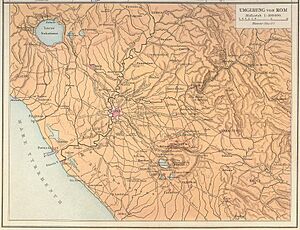Battle of Mount Algidus facts for kids
Quick facts for kids Battle of Mount Algidus |
|||||||
|---|---|---|---|---|---|---|---|
| Part of the Roman-Italic Wars | |||||||
 Surroundings of Rome in Antiquity |
|||||||
|
|||||||
| Belligerents | |||||||
| Roman Republic | Aequi | ||||||
| Commanders and leaders | |||||||
| Lucius Quinctius Cincinnatus, Lucius Minucius Esquilinus Augurinus |
Cloelius Gracchus | ||||||
The Battle of Mount Algidus was a super important fight in 458 BC. It happened between the Roman Republic and a group called the Aequi, near Mount Algidus in a place called Latium. The Roman leader, Lucius Quinctius Cincinnatus, who was a dictator (a special leader chosen in emergencies), turned a likely Roman loss into a big victory.
Contents
Why the Battle Happened: The Background
Rome's Neighbors and Challenges
Back then, the government of Rome was shared by different groups. These included the original Romans, the Latin people, and the Sabine people. For example, the Quinctia family, who were very important in Rome at this time, were originally Latin.
Rome also had allies, like the Hernici. Other groups, like the Etruscans, were not causing trouble, even though their town of Veii was close to Rome.
Who Were Rome's Enemies?
The biggest enemies of Rome during this period were the Volsci and the Aequi. The Volsci lived to the southeast of Rome. The Aequi lived to the east, in the Apennine Mountains.
The Aequi often attacked Rome and the areas around it. Sometimes they attacked alone, and sometimes with friends. They especially moved towards a town called Tusculum. Their attacks made it hard for people to trade and travel along the Via Latina road. This caused problems for all of Roman territory.
Problems Inside Rome
At this time, Rome itself had some difficulties. There were disagreements between the patricians (the wealthy, powerful families) and the plebeians (the common people). There was also a revolt by slaves in Rome.
During this revolt, the slaves took over the Capitoline Hill, which was home to Rome's most important temples. A Roman leader called Publius Valerius Poplicola died during this time. The revolt only ended when an army from Tusculum arrived, led by their leader Lucius Mamilius. After this, Cincinnatus was chosen as a consul to replace Publicola.
Aequi Attacks and Roman Response
In 459 BC, the Aequi took over Tusculum. To help their ally, the Romans sent an army led by Consul Lucius Cornelius Maluginensis. Another consul, Quintus Fabius Vibulanus, who was fighting near Antium, also moved his soldiers to attack Tusculum.
In the end, the people of Tusculum got their city back. Vibulanus killed many Aequi near Mount Algidus. After this, Rome and the Aequi agreed to a truce, which is like a temporary peace.
The Truce Breaks
The very next year, 458 BC, the Aequi broke the truce. They attacked Tusculum again and set up camp near Mount Algidus. At the same time, an army from the Sabine people moved towards Rome.
Rome quickly put together two armies. Consul Gaius Nautius Rutilus planned to attack the Aequi's own lands. His partner, Lucius Minucius Esquilinus Augurinus, planned to fight the Aequi camped near the mountain.
Minucius, however, did not attack the Aequi. Instead, the Aequi started building a fort all around the Roman camp during the night. Since Nautius didn't know what to do, Cincinnatus was chosen as dictator. A dictator was a special leader given full power during a crisis. Cincinnatus had just finished his time as consul.
The Battle at Mount Algidus
Cincinnatus Takes Charge
Cincinnatus quickly chose his magister equitum (a cavalry commander, second in command). He then gathered every available Roman man in the Campus Martius (a large field in Rome). He told them to bring enough food for five days. He also asked them to bring twelve valli each.
A vallus was a strong wooden pole that Roman soldiers used to build protective walls around their camps. Asking for twelve valli instead of just one was very unusual! It showed Cincinnatus had a special plan.
Surrounding the Enemy
The Roman army, led by Cincinnatus, reached Mount Algidus by nightfall. Cincinnatus sent a signal to the trapped Roman soldiers under Minucius, letting them know he had arrived. Then, he ordered his own men to build a wall all the way around the Aequi's camp.
The Aequi tried to attack Cincinnatus's army. But they soon had to turn around. This was because the Romans under Minucius had left their own camp to help their fellow soldiers.
Roman Victory
By dawn, the wall around the Aequi was finished. Cincinnatus ordered his men, who had marched and worked all day and night without rest, to attack the Aequi inside the wall. The Aequi were now being attacked from two sides. They couldn't fight off both Roman armies at once and had to give up.
Cincinnatus let most of the Aequi soldiers go free. He only kept their leaders as prisoners.
What Happened Next: The Aftermath
Spoils of War and Recognition
The valuable items and supplies taken from the Aequi's camp were given to Cincinnatus's soldiers. However, the Roman soldiers who had fought under Minucius were not seen as brave, and Minucius himself had to step down from his role as consul.
The Aequi leaders were brought to Rome as prisoners. Cloelius Gracchus, who was the Aequi commander, was paraded in Cincinnatus's triumphal procession. A triumph was a special parade given to Roman generals after a big victory.
Cincinnatus's Legacy
Cincinnatus then gave up his power as dictator. He had held this special role for only sixteen days! This showed he was a true Roman hero who only took power when needed. Lucius Mamilius, the commander from Tusculum who had helped Rome earlier, was rewarded with Roman citizenship.

